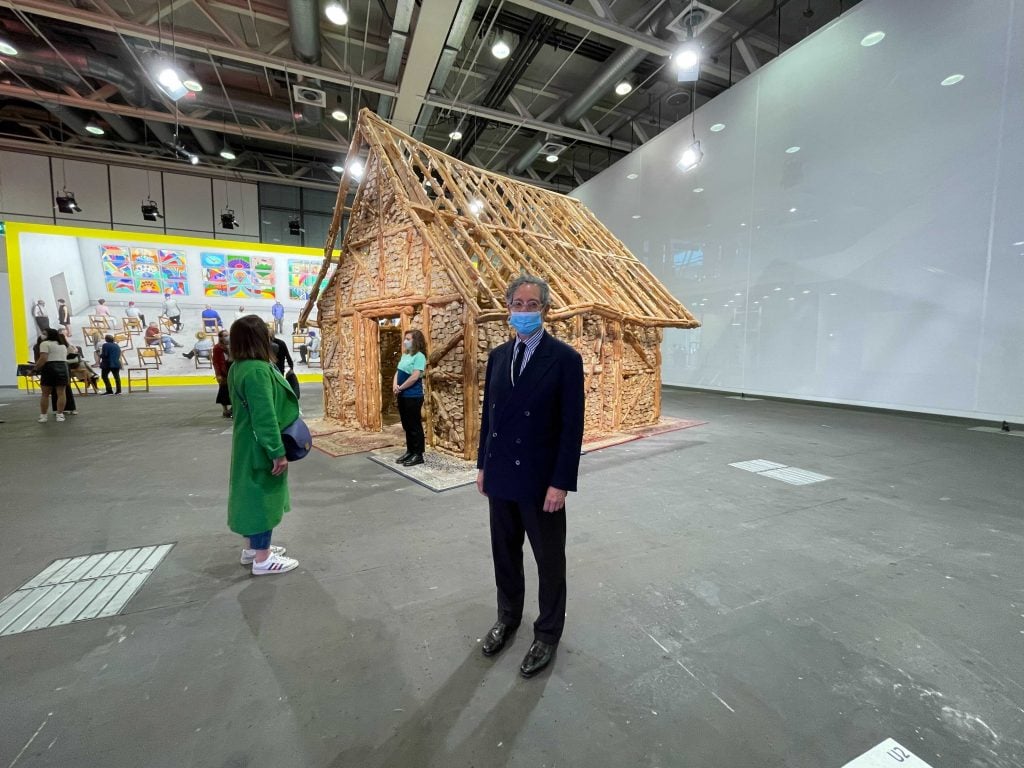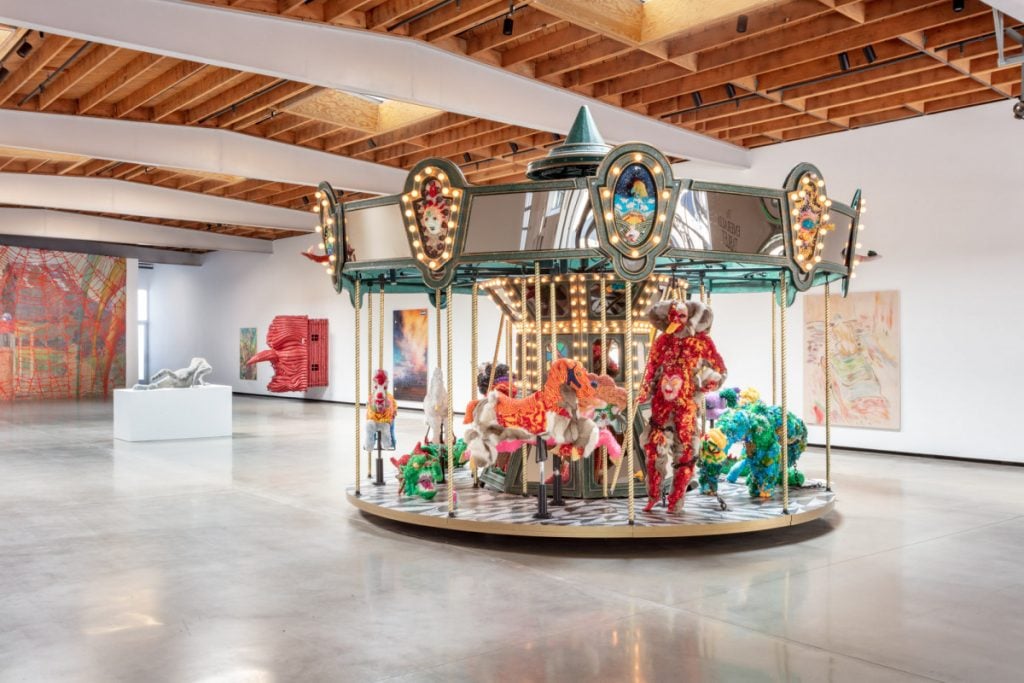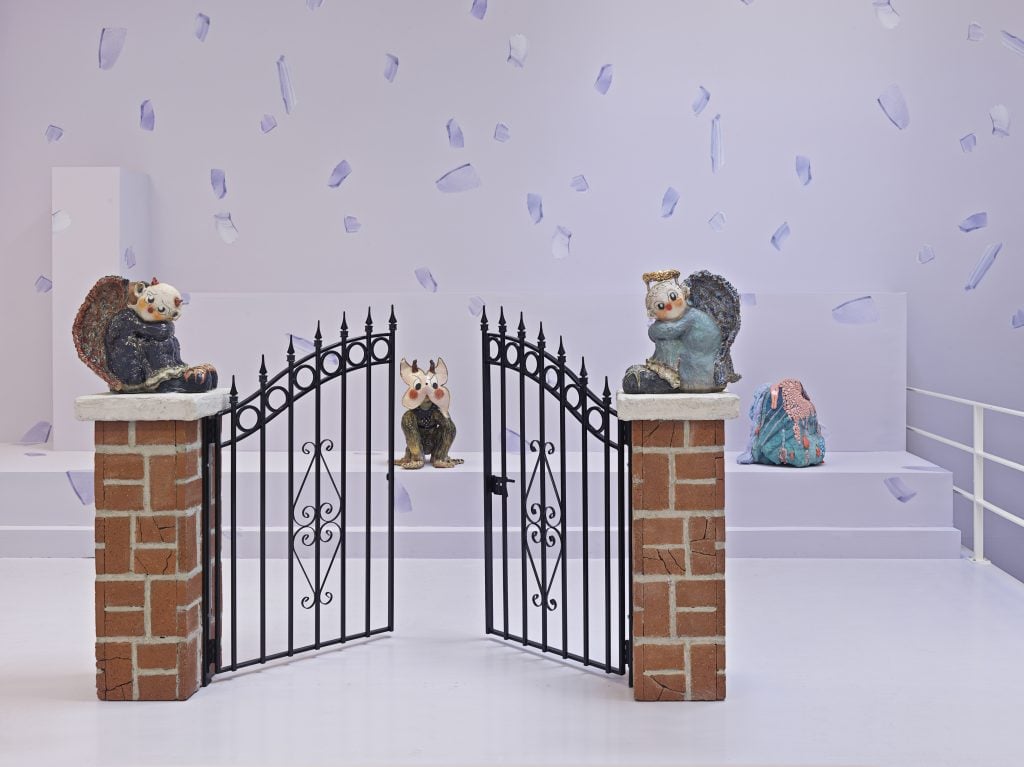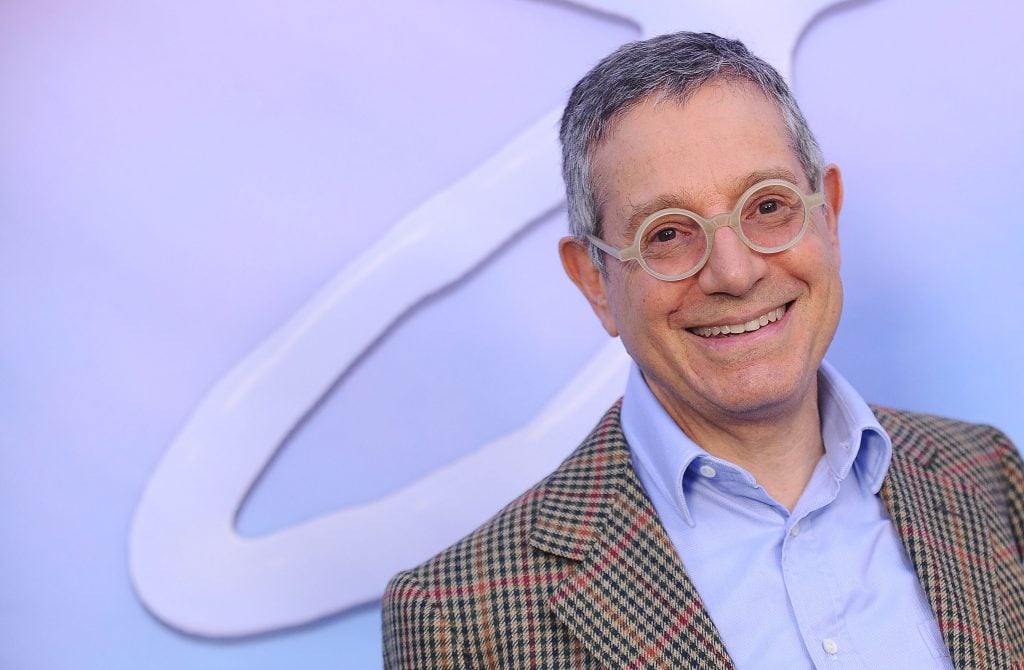Over the course of a 50-year career, Jeffrey Deitch has played numerous roles, working as a dealer, museum director, advisor, writer, and curator.
He’s also a prolific talent scout, helping launch the careers of some of the biggest stars of the 20th and 21st centuries, including Jean-Michel Basquiat, Keith Haring, Jeff Koons, and Cecily Brown.
Opening Deitch Projects in 1996, the Harvard Business School graduate was among a fresh crop of dealers that applied savvy strategies to the art market, forming a multipronged enterprise combining an exhibition platform for new work with a secondary-market arm and advisory service—a model that has since been adopted by countless competitors.
Prior to founding his gallery, Deitch worked at Citibank, where he helped establish the bank’s art division, introducing art consulting and art-backed loans. In 2010 Deitch closed the gallery to take the helm at the Museum of Contemporary Art in Los Angeles, a controversial tenure that ended after just three years.
With a lean team of 13, he has since re-established a bicoastal gallery with spaces in New York and Los Angeles, where he’s rekindled an insatiable and lifelong fascination with the new, producing shows with forward-thinking creators, such as the painter Dominique Fung and the performer Miles Greenberg.
In conversation with Artnet News, Deitch spoke about what keeps him going after all these years, how past crises helped him navigate the pandemic, and the most challenging job of his career.

Jeffrey Deitch at this year’s Art Basel with Urs Fischer’s Untitled (Bread House) (2004–06). Photo: Kate Brown.
The last 18–24 months has been a time of unprecedented change, and the art world has been part of that, too. How have you experienced this period of crisis and transformation?
A lot of the issues that have come up are issues that my team and I have been thinking about for some time: issues of social justice, opening up to a more diverse audience. I’ve been gratified to see the art world responding to a lot of these forces.
And what about the pandemic?
A lot of what gallerists do is based on relationships. We used the shutdowns to connect in a more profound way with artists, collectors, and curators, and had more time for conversations. We were also one of the first galleries in Los Angeles to reopen at the beginning of August 2020; most were still closed and the museums weren’t open yet, so we were one of the only venues in town where people could see art.
Attendance was very strong, but since we couldn’t have a regular opening, we had to rethink how to engage with the public. For example, we reopened with a remarkable exhibition of 250 Kenny Scharf tondos, and since Kenny is also known for his ‘car bomb’ project, for which he’s painted more than 250 cars, we sent out a note to the owners of these vehicles in the L.A. area to schedule a rally which could take place safely outdoors. We had a tremendous response, with over 50 of these cars showing up, and hundreds of people saw the rally drive through West Hollywood, ending at the gallery.
I also helped start the Gallery Association Los Angeles, which includes an online sales platform. It was a time to come together, and I had more time on my hands than usual. It is something very significant that probably wouldn’t have happened if it weren’t for the pandemic.

Installation view, “Kenny Scharf: MOODZ,” at Jeffrey Deitch, Los Angeles. Photo: Joshua White.
How has the Covid era compared to previous times of crisis, such as the 1990s market slump, post-9/11 period, or the financial crisis of 2008? What did you learn from those hard that has helped you weather this latest tumultuous period?
I’ve been in this field for 50 years, so I’ve experienced all of the ups and downs. In the early ‘90s prices for some of the popular artists of the late ‘80s dropped by 90 percent, there was a very significant drop in the prices of historical artworks, too. There were a number of reasons for this, including the sudden withdrawal of the entire Japanese sector, which was very active at that time. And it didn’t only affect the art market; there was a decline in real estate and other assets at the same time—and, well, there was a reckoning. For me, as an art dealer it was one of the best opportunities to buy, and I was able to get really great works of art, which I still have. It was an unprecedented opportunity that also allowed me to buy the properties I still have in SoHo. When prices are lower it’s not a time to run away, it’s a time to buy if you can, because things bounce back—often higher than before.
The 2008 financial crisis hit some people in the art world, but it didn’t affect us that much. This is a very rarified market, and our good clients on the top end were pretty secure. And the people who buy the new art, well, it’s not that expensive.
In contrast, when the pandemic first became serious, we were preparing to not sell anything for at least a year. For the first month or two, it didn’t feel appropriate to offer artworks to collectors; it just wasn’t the right thing to do in a time of crisis. But after a month or two collectors started calling and it turned into a period of connection. A lot of our clients are normally very busy running businesses and we can only get them to pay attention during an auction week or a fair. But they would call up to say, ‘Hey, what’s going on?’ or ‘What can we do?’ I would have hour-long conversations and Zoom calls with collectors, and the gallery actually ended up doing very well. People were stuck indoors, but they could still buy a painting or sculpture and have it sent to their home to enjoy. The art market is also increasingly global, and there was a lot of activity from Asia, where a whole group of young people follow art online, which became significant for us during this period as well.

Jeffrey Deitch attends the opening of “JR Chronicles” at the Brooklyn Museum on October 2, 2019, in New York City. Photo: Gonzalo Marroquin/Patrick McMullan via Getty Images.
Unlike some dealers that have been in the game for as long as you have, you still seem to have a genuine curiosity for what’s new. What keeps you interested in discovering fresh perspectives?
I started doing this when I was a teenager. This is what I’ve always done and what I love to do. It’s so rewarding to connect with young artists and gain insight into what’s going on in our society.
I was friendly with a number of the great dealers and critics. Some of them were always excited about what’s new and fresh, and others stopped at a certain generation and couldn’t go beyond. I determined I was not going to be like those that stopped with their own generation.
How do you find or discover young artists? And what characteristics do you look for in artists that you show at the gallery?
I don’t look for individual talents; I look for communities of talent. Going back to the beginnings of Modernism, or even back to pre-Modern art, the best artists often knew each other and formed communities. If you study the history of Impressionism, Cubism, or Surrealism, the key artists all knew each other, shared studios, and participated in discourse. Almost all important innovations in art come out of those interactions. So I try to find these communities. Early on in my own history I was very involved with the community surrounding Keith Haring, Jean-Michel Basquiat, Kenny Scharf, and Rammellzee. The energy they brought pushed the art world in a whole new direction. So what we do with the gallery is try to provide a platform for these communities.

Installation view of Ariana Papademetropoulos, “The Emerald Tablet,” at Jeffrey Deitch, Los Angeles. 2021. Photo: Joshua White. Courtesy of Jeffrey Deitch Gallery.
Many of your recent exhibitions have been very innovative and unexpected, and have spanned a large cross-section of contemporary art. I’m thinking of the Ariana Papademetropoulos show you presented, or the “Clay Pop” exhibition. Can you talk about the strategy behind this broad variety of shows, and what these very different exhibitions have in common that makes them ‘Deitch’ shows?
I am always trying to identify and articulate artistic trends. It is a challenge to not just discover outstanding artists, but to try to understand an emerging artistic direction. I started on this mission in 1975 with “Lives,” an exhibition about artists who used real life as an art medium. Over the years, I have presented Artificial Nature, Post Human, Form Follows Fiction and other thematic projects. We are continuing this tradition with “Shattered Glass,” “Clay Pop,” and the upcoming “Luncheon on the Grass” in the New York and Los Angeles galleries.

Installation view, “Clay Pop” at Jeffrey Deitch, New York, 2021. Photo: Genevieve Hanson. Courtesy of Jeffrey Deitch Gallery.
Another interesting thing I noticed is that you often like to invite artists to curate shows. Austin Lee’s exhibition last year or Nina Chanel Abney’s show in 2018 come to mind. Why do artists make good curators?
We do have a tradition of artist-curated exhibitions. Artists are often the most astute observers of artistic trends. In addition to an intuitive understanding of artistic innovations, artists like Nina Chanel Abney are at the center of the creative discourse, with networks of friendships with other innovative artists. We are currently presenting “Self-Addressed,” curated by Kehinde Wiley, in our Los Angeles gallery. It is an exhibition of self-portraits by 44 emerging African artists, with the sale proceeds to benefit Kehinde’s residency program, Black Rock Senegal.
As someone who has taken substantial risks to show different genres of visual art to attract wider and younger audiences—to the point where you’ve been criticized for it—why do you encourage inclusivity when so much of the art world reinforces exclusivity?
My first serious job was as an assistant at the John Weber Gallery, which represented the strongest Conceptual and Minimal artists. The artists were very socially aware and engaged, but they were not focused on reaching a large audience.
I also grew up in the prime of the counterculture of 1968, and my inspiration was the great rock musicians who put out serious and socially challenging music that was also accessible. I wondered, why visual art can’t be this way? Why can’t visual art have the impact of rock groups? I think it comes down to the transistor radio, which came out when I was a kid—it really made music accessible to so many young people, but there was no equivalent for visual art. Today everybody has a camera on their phone, and the ubiquity of platforms like Instagram and TikTok has brought young people’s visual fluency to a totally different level. Now there is greater potential for visual art to have an impact, equivalent to rock music in the 1960s and 1970s. For example, over the course of an exhibition we might get a somewhere between 100 and 500 visitors a day, many of whom post about it to Instagram. It’s a level of exposure that’s way beyond anything I experienced back in the ‘80s, ‘90s, and 2000s.
I want to talk about your influence on street art, arguably one of the most inclusive art forms. You’ve had a massive impact on the acceptance of urban genres in the fine-art space. Can you talk me through your interest in it, starting from your relationships with Basquiat and Haring right through the “Art in the Streets” show you did at L.A. MoCA?
I came to New York City in 1974 and was enthralled by what was going on in SoHo. The artists showing with John Weber became my friends, but I was equally astonished by the tagging and ‘wild style’ that was going on in the subway. It was thrilling to see Keith Haring’s chalk drawings and fully painted train cars. I sought out the people doing this and got to meet Dondi, Crash, and Fab Five Freddy. I was also amazed by Samo, and eventually I got to meet Jean-Michel [Basquiat]. These were artists of my generation who excited me more than anyone at that time. My first significant contribution as an art critic was a report about the “Times Square Show” covering a number of these innovations. It was the first time anyone had written about Jean-Michel Basquiat instead of Samo. I’ve been involved with these artists from the beginning, and one of my missions has been to show that street art is important art, not some subcategory. It deserves historical analysis like Minimal, Conceptual, or any other artistic movement.
Art-world insiders resisted this for a long time, and I was determined that my first big effort at MoCA in 2011 would be a history of ‘art in the streets.’ It was the most ambitious and impactful show I’ve ever done. We brought a whole new audience to the museum and it was a breakthrough, because other museums are now embracing this work and are treating it seriously.

Members’ reception for “Art in the Streets” at the Geffen Contemporary at MOCA Los Angeles, April 16, 2011. Photo: Ann Johansson/Corbis via Getty Images.
In many ways your interest in the street feels like a contradiction. You come from a finance background, you exclusively wear tailored suits—but at the same time, you’re this massive promoter of urban culture. How do you explain this dichotomy?
I don’t see any dichotomy. These innovators are great artists, right? I’ve always respected them in the same way I respect any great innovator of art. I don’t differentiate. What these teenagers did in Brooklyn, the South Bronx, and Lower Manhattan might actually be the most influential art movement since Pop art, because wherever you go in the world, you see echoes of wild style. It’s remarkable how this connected with people all over the world.
Rewinding for a moment to your time at Citibank: you built one of the first art advisory businesses there. I’m curious to hear what you make of the proliferation of this profession? I’m sure you’ll agree that it sometimes feels like there are more advisors than actual buyers.
Sometimes I joke that I created a monster. What we did at Citibank was the world’s first professional art advisory service. We established a lot of the field’s basic structures and approached it in a very rigorous way—the same way an investment advisor would approach financial advice, with set fees, contracts, and a system to avoid conflicts of interest, but also things like condition analysis, which wasn’t widespread at the time.
Some people misunderstood what we were doing and thought we were creating investment portfolios, but it was really about access. People all over the world wanted to get involved with art collecting, but couldn’t. When we started, for example, Sotheby’s and Christie’s didn’t print auction estimates in their catalogues—they would have a separate sheet with the estimates, but you had to ask for it. Then they started printing the estimates on the back page, but it was really hard to see. The dealers, who were the dominant auction buyers at that time, didn’t want the information to be accessible to collectors, because they wanted collectors to have to go to them to buy art.
Most people didn’t understand the values. Say you’re a collector in the midwestern United States, outside of the art-world networks. How are you going to get access? How would you know whether you should be bidding $100,000 or $200,000? We worked with a whole network of conservators and art historians to give people reliable, expert advice. We also introduced lending against art, a service that art collectors are increasingly taking advantage of, and has been of great help to collectors from a financial point of view. In short, we were able to help our clients approach this difficult market with a lot of confidence, and built a business that’s still thriving today.

Jeffrey Deitch at Art Basel, Miami Beach, December 2002. Photo: Rose Hartman/Getty Images.
Your gallery is unique for an operation of its size since you have quite a few different revenue sources, including sales from gallery shows, a private advisory service, and secondary-market sales. How has your MBA and your time on Wall Street helped you build a diversified business? And what can other small and medium-sized dealers learn from this structure to compete with large multinational galleries and auction houses?
This whole business is based on relationships. Some of mine go back 50 years. In some cases I’m now working with the grandchildren. Really serious people in art are a small group, so you don’t need 200 of them. A relatively small number of relationships with great collectors—some who are involved in more historical work, some more contemporary—is very sustaining.
That’s what my whole enterprise is based on; it has nothing to do with Harvard Business School. The best lesson from Harvard Business School was that having a larger strategy is more important than thinking about individual transactions.
Do you mean that in terms of what kind of artists you work with?
Well, everything’s strategic. Rather than just saying, ‘Oh, I just show what I like,’ let’s apply some strategy to it: What are we really doing? What’s our mission? It’s also very important to understand who your clients are, what their businesses are, and how they think. But overall our business isn’t that different from what a picture dealer might have done during the Renaissance.
Having participated in so many sectors of the industry, which has been the most challenging for you? And what have you learned from each of these roles?
I see it all as part of the same thing. It’s all about contributing to visual culture. You can do it by having a gallery in SoHo, working at Citibank, or running a major museum.
But there’s no question that my most challenging job was being a museum director. Balancing all the constituencies is exceptionally difficult, and doing my own thing is much easier. I don’t regret my tenure at MoCA; we did amazing things there, and I had so many friendships come out of that.
And of course, it brought you to L.A. I suppose, right?
Yes, it’s fascinating to open up this new chapter in Los Angeles. But we’re still very active in New York City and other cities around the world.
Do you have plans to expand abroad in the future?
Outside of the United States, it’s more interesting for me to work with foundations and museums than to actually have a commercial gallery. I really don’t need to do that, because we have strong presence with the shows we curate. For example, I’m curating an Alex Israel exhibition at the Fosun Foundation in Shanghai, opening on November 10; we’re working on a street art show at the K11 Foundation in Hong Kong, which includes the first book about the history of street art to be translated into Chinese; and there’s a major project in India I’ll be able to reveal details about soon.













